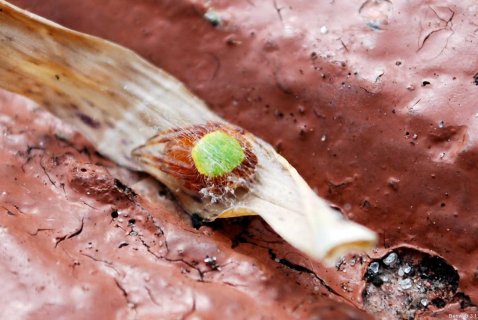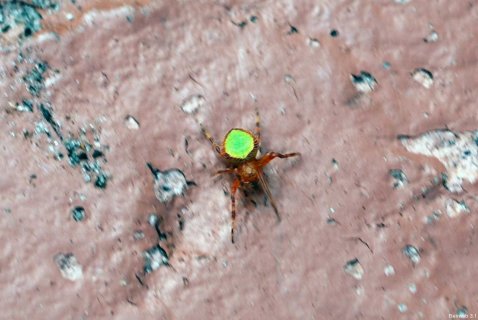How about a spider post for Halloween?
While watering the still-tender plants in the front yard last week (and incidentally invoking a 5-inch overnight rainfall, courtesy of former Tropical Storm Rina) I came across several interesting little creatures that I hadn’t met before. It’s astonishing what diverse wildlife even an incipient native plant garden can accommodate. One of these little guys is a small spider, Eriophora ravilla, one of several distinct species called tropical orb weavers.
I found this little guy tightly curled up in a dead blade of grass, sealed in by its own silk:
Once I blew its cover by bending the folded blade backward, stretching/breaking the silk, it was off like a rocket:
According to the information I’ve found, this spider has several different color forms. Some females have a distinctive “irregular asymmetrical longitudinal white pigment patch” that makes them rather striking-looking, but as far as I can see those that are patterned like the one I found, with that brilliant green back, are the prettiest. (Since this pattern seems to belong to the males, I suppose I should say “handsomest.”)
Someone (Matt Edmonds) posted an absolutely stunning picture of one of these guys from Pinellas County over at bugguide.net; you owe it to yourself to hit that link and see what this spider really looks like.
The information sheet at the UF/IFAS featured creatures website confirms what I thought about most (but not all) orb weavers in Florida: they put up their webs at night and take them down by day. Thus, “E. ravilla is not a conspicuous member of the diurnal fauna during its adult stage.”
And where do you find them during the day? Exactly where I did: “During the day, E. ravilla may be found on the underside of leaves which are partially rolled and tied with silk, or occasionally in sparse silken retreats in sheltered corners of man-made structures.”
To give you an idea of scale, the diameter of the curled-up spider is about 1/4 inch. Yep. It’s small.
The genus name, Eriophora, is Greek. Erion means “wool” while eriole means hurricane; I’m not entirely sure which root it’s from, but I suspect the former, since the latter would form eriolophora. You might recognize the suffix phora from other words like amphora; it means “carrier.” The specific epithet, ravilla, is a common surname. I’m not sure who Carl Ludwig Koch, who named this and hundreds of other species of arachnid, was honoring with it.


